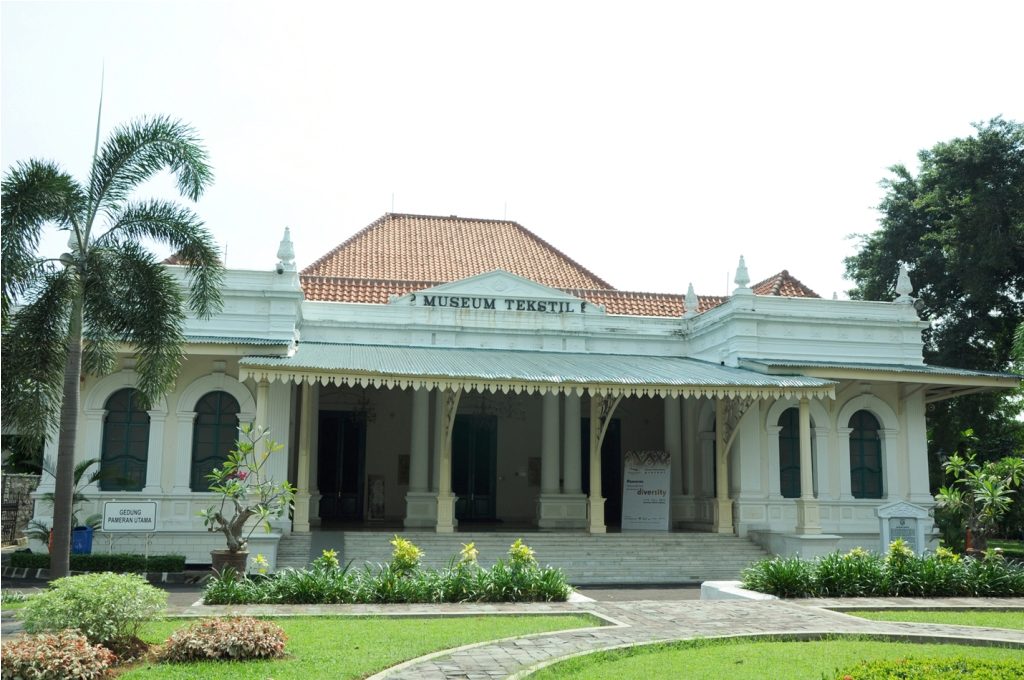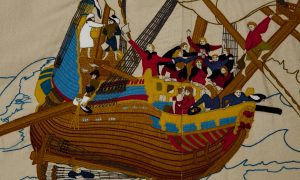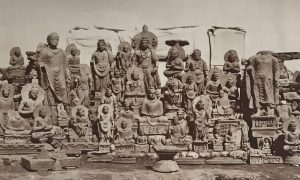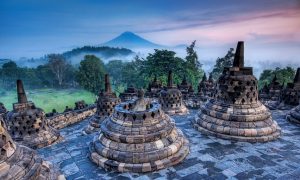While in Jakarta recently, I had the good fortune of meeting with Isla Winarto, outgoing President of the Indonesian Heritage Society (IHS), at an exhibition at the Museum Tekstil (Textile Museum). The IHS dates to 1970, when a small group of mostly expatriate heritage enthusiasts came together to support the Museum Pusat (now the Museum Nasional, or National Museum). The Ganesha Volunteers, as they were known for many years, initially focused their efforts on document translation and inventory work, but soon branched out to include museum tours and lectures.
Today, IHS is a non-profit, Jakarta-based volunteer organisation with over 600 members from dozens of countries. While it remains a largely expatriate organisation, Winarto prefers to emphasise the ‘multinational’ nature of its membership as a way of demonstrating the widespread interest in Indonesian heritage practices and traditions. These members continue to work closely with the Museum Nasional, as well as a number of other Indonesian museums, to raise awareness about Indonesia’s cultural heritage.
I took the opportunity to ask Winarto about some of the work that IHS has been doing to support and promote sustainable heritage practices in Indonesia, and the organisation’s work with the Museum Tekstil in particular.
NP: What does the Indonesian Heritage Society do?
IW: The main objectives of the IHS are to promote an understanding and appreciation of Indonesia’s rich cultural heritage among its more than 600 multinational members, and to work cooperatively with Indonesia’s museums. At IHS, volunteers arrange numerous activities, including lectures and morning talks, conducting free tours of the Museum Nasional, exploring Jakarta in small groups, coordinating special interest groups, organizing morning coffee with guest speakers, and taking cultural trips across Indonesia.
NP: Can you tell me about the specific work your team of volunteers has been doing at the Museum Tekstil, Jakarta?
IW: In 2016, IHS entered into a Memorandum of Understanding with the Museum Seni (Museum of Arts) in Jakarta, comprising the Museum Tekstil, the Museum Wayang (Wayang Museum) , and the Museum Seni Rupa dan Keramik (Museum of Fine Arts and Ceramics).
To date, our focus has been mainly on cooperation and collaboration with the management and staff of the Museum Tekstil. As part of this agreement, IHS has promoted exhibitions at the Museum Tekstil to our members, as well as through social media. We have also helped to organise workshops led by international experts in areas such as textile conservation. The Museum Tekstil, for its part, has provided access to IHS members and volunteers to its vast textile collection and staff expertise. This has enabled IHS volunteers to become better acquainted with the textiles of Indonesia, including the intricate production processes and techniques.
In 2017, IHS, working side by side with Museum Tekstil personnel, formed a Museum Conservation Group, through which IHS members volunteer their time on a weekly basis to assess the condition of textiles housed at the Museum. This information, combined with brief descriptions of each piece, is then entered into an online database by IHS.
In addition, IHS volunteers prepared an inventory of the 2,500 books available at the Museum’s library, allocating Dewey Decimal Classification to each book. This library catalogue is being added to an Online Public Access Catalogue (OPAC).
In 2018, IHS volunteers – some experienced weavers themselves – commenced work on rehabilitating the Museum’s looms, the aim being to educate the public, especially young people, on weaving techniques.

Museum Tekstil, Jakarta. Source: ASEMUS
NP: Why is this work important?
IW: This cooperation plays an important role in supporting the Museum Tekstil to achieve its vision of becoming a major research establishment, complete with an accurate and up-to-date Indonesian textile database, especially for future generations. Equally as important is the Museum becoming a key centre for information and education on Indonesia’s textiles, ranging from production techniques, colour and dyeing processes, designs and their historical significance among Indonesia’s hundreds of ethnic groups.
This collaborative work between the Museum Tekstil and IHS also serves to raise awareness and develop an appreciation among IHS members of the wealth of fascinating and often exquisite textiles available across the Indonesian archipelago.
NP: What are the main challenges faced by Indonesia’s heritage institutions?
IW: General maintenance of museums or places of historical significance, funding for conservation efforts, and staff training and development are among the main challenges currently being faced by Indonesia’s heritage institutions.
In certain museums, there is also the problem of outdated equipment, a lack of security and disaster preparedness, all of which could lead to huge material losses at Indonesia’s cultural institutions, in the event of a natural disaster (eg flood, fire, earthquake) or theft. Cultivating a stronger interest in Indonesia’s heritage institutions among both young and old must also be a priority for the government.
NP: What opportunities are there for Indonesia to improve its heritage management practices?
IW: Improving heritage management practices, in particular supporting the conservation of cultural items, requires funding, skilled and trained staff, best practice methods, community awareness programs, and promotional planning. Responsibility in all these areas could be shared across both the public and private sectors.
Educating the public to appreciate their cultural heritage needs to start with young children, and continue through to higher educational levels. This could be achieved through school visits to museums, teachers being better trained to educate students about the cultural significance of certain periods in Indonesian history, internships at cultural institutions for young people, exchanges with international experts in conservation and museum design and layout, free tours to museums and places of historical significance in general, and free exhibitions open to the public.
Follow the conversation on PoP’s Facebook page!
 Facebook
Facebook  Twitter
Twitter  Soundcloud
Soundcloud  Youtube
Youtube  Rss
Rss 


